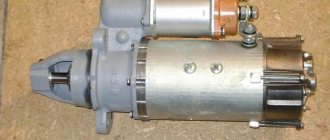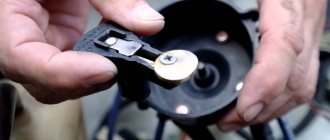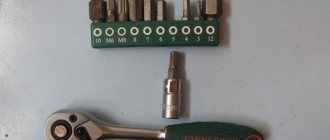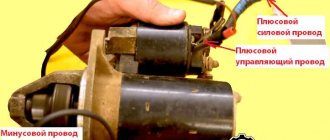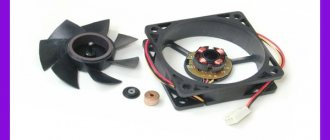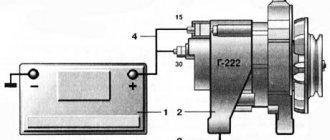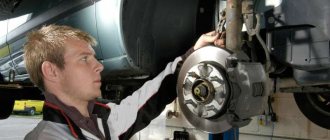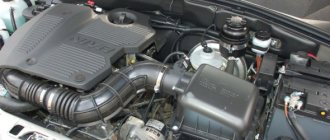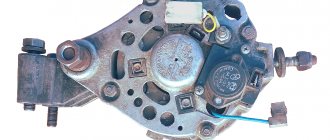The starter is a component that no vehicle can do without, since this element is one of the main ones in the ignition system. As you know, there are no parts that last forever, and from time to time the starter unit tends to fail. You can learn more about what malfunctions are typical for this element and how to check the car starter armature on your own at home from this material.
Possible armature malfunctions
Malfunctions associated with the starter unit, one way or another, affect the entire ignition system. You will know immediately about the failure of the unit, since without it it is impossible to start the engine.
The main malfunctions characteristic of this device:
- collector wear, which may be uneven;
- short circuit between the turns of the windings of the unit;
- an insulation breakdown to ground has occurred;
- collector contacts are unsoldered;
- The studded elements under the bushings are worn out.
So that you can solve this kind of malfunction on your own, it will be useful for you to know how to check the starter armature. We will tell you more about diagnostics and repair below.
Checking the starter unit with a tester
Other starting system failures
Now that all the breakdowns have been sorted out and it has been figured out how to check the starter for functionality, we can mention one feature. The fact is that very often the flywheel crown wears out and starting the engine becomes impossible - the starter gear does not engage the teeth. You can fix this for free, you just need to remove the gearbox, knock off the crown, warm it up and install it back on the flywheel.
The starter is a component that no vehicle can do without, since this element is one of the main ones in the ignition system. As you know, there are no parts that last forever, and from time to time the starter unit tends to fail. You can learn more about what malfunctions are typical for this element and how to check the car starter armature on your own at home from this material.
Anchor repair
One of the most common problems in the operation of the armature of the starter assembly is a short circuit, in particular, we are talking about the windings located on the housing. In order to solve this problem, you will need to carry out a visual diagnosis of the outputs of the inka, as well as the wiring of the element. By doing this, you will be able to find the place where the breakdown occurred. After it is found, it is necessary to clean the contacts and diagnose the resistance; a multimeter is used for this. After this, you should insulate the broken area, for which you can use super glue with asbestos.
If a visual check does not allow you to find the location of the breakdown, you can use another method for diagnosis. It consists of connecting all the lamellas of the device together, but for this it is necessary to use a special stripped wire. When the lamellas are closed, voltage will need to be applied to the device (to the commutator and ground), and since it must be as high as possible, this may require a welding machine. Actually, this is precisely the complexity of the method. The place where there is a breakdown will burn out (video author - Konstantin Petrakov).
In the event that an interturn short circuit occurs in the operation of the unit, such a problem can be determined using a special device. That’s what it’s called - PPYA - a device for checking the anchor. As practice shows, short circuits are often caused by the use of bent or crumpled wires or the presence of conductive particles between them. If this is the case, then it is necessary to correct all the problems (align the wires and clean them of debris), and then apply a layer of varnish on top, this will protect the device. If this method does not help you find the problem, you can rewind the armature yourself.
As for a short circuit, it usually affects the functioning of the collector. Subsequently, this can lead to burnout of the plates, as a result of which this element can completely collapse. If you have to solder, remember that before soldering the working surfaces must be thoroughly cleaned; you can use a drill for this. Using this device, you can perform a good cleaning of contacts, as well as lead wires. When the wiring is installed back into the so-called cockerels, it will need to be checked using an armature diagnostic device.
If you will be soldering, we recommend purchasing inactive flux as a material, as well as tin. Before starting the process, the soldering iron should be warmed up as much as possible, this will allow you to achieve the desired result. It is also necessary to warm up the wires, since the solder must melt well so that it can get into the soldering area. When the soldering is completed, it will be necessary to treat this area with a solvent, and then again diagnose the armature using the device.
As practice shows, our compatriots often face the problem of wear of collector plates, and uneven wear. In addition, the commutator can even move relative to its axis - all these malfunctions are usually caused by wear of the brush assembly or the commutator as a whole. If we talk about plates, then this problem manifests itself as a result of a loose fit of the brush elements, which contributes to the formation of a so-called arc during operation, which wears out the plates. If this is the case, then grooving the manifold will solve the problem, but keep in mind that this will require a special lathe. When the grooving is completed, the device will need to be cleaned of chips and other dirt that could cause it to malfunction.
Read also: Can Ip44 be installed outdoors?
Scheme and principle of operation
The starter is one of the most conservative components of a car. Such an electrical device was first tested by Charles Cattering in 1912, that is, more than a hundred years ago. At first it also served as a generator.
But in the form in which the starter is used to start modern cars with internal combustion engines, it owes its name to the American inventor and auto industrialist Vincent Hugo Bendix, who immortalized his name in one of the main parts of the starting device.
A typical functional diagram of a starter is shown in the figure:
The principle of operation of the starter is almost the same for all car models with internal combustion engines. When the ignition switch is turned to the “Start” position, a starting current is supplied to the retractor winding.
This, in turn, drives the traction relay armature and the contact spring rod. The traction relay acts on a lever, usually called a yoke, which pushes the freewheel and gear (Bendix) into engagement with the flywheel. At the same time, the contact plate closes the coins, through which voltage is supplied to start the starter motor.
The typical functional diagram of a starter is so well thought out and tested that the difference between starting device models lies only in the design features and materials from which the components are made.
However, starters have their own vulnerabilities:
- solenoid relay;
- electric motor brushes;
- nickels;
- fork;
- freewheel;
- gear;
- armature collector;
- armature bushings;
- damper spring.
In fact, almost every component of this device can become unusable during operation. This is due, first of all, to the fact that when starting, especially in the cold season, the starter produces a lot of power, experiences extreme loads, and huge currents flow through it.
Video “Repairing the starter unit at home”
How to properly repair a device and what nuances need to be taken into account - learn from the video (author - AUTO RES channel).
The ability to start the engine by turning the ignition key from inside the car and without much physical effort can easily be considered one of the most significant achievements of designers in terms of improving the consumer qualities of a car. However, sometimes it happens that you cannot start the car with an electric starter. The reasons for such an unpleasant event are varied, but the list of the most likely among them includes a malfunction of the solenoid relay. A savvy car enthusiast is able to quickly localize and diagnose such a breakdown on his own, after which he can carry out repairs and restore the vehicle to normal operation without contacting a service center and with minimal financial costs. An assistant will be required to perform some of the checks.
Signals of imminent starter failure
If the starter fails to crank the engine or rotate it at a speed inappropriate for starting, then the electrical part is faulty. Therefore, you need to start checking all the starter circuits, starting from the battery.
If the failure is mechanical, the working starter does not rotate the engine, grinding and buzzing sounds are heard. In such cases you should check:
- fork and freewheel;
- overrunning clutch lever;
- coupling ring;
- buffer spring;
- gearing.
When the starter can be turned on only with 2-3 turns of the ignition key, the gear slowly disengages from the flywheel crown, and there is a lot of strain in operation, even if the battery is 100% charged!, then these are sure signs that the unit will soon fail.
We recommend: Changing the oil in the automatic transmission and Chevrolet Cruze engine
Purpose and design of the retractor relay
The starter solenoid relay is a two-winding traction electromagnet that has a movable core with a return spring and is used to activate the overrunning clutch. Often, for reasons of increasing overall reliability, it is structurally designed as one of the functional blocks of the starter.
The engine starts from the starter due to the rotation of the flywheel in the desired direction, which occurs through the corresponding gear. Therefore, when current is supplied to the retractor winding of the relay, the starter (Bendix) clutch gear is moved to the operating position and engages with the flywheel ring gear, further compressing the return spring. When the clutch reaches its extreme forward position, to reduce current consumption, the retracting winding is turned off and only the holding winding remains under current. Then the starter motor turns on.
Constant engagement of the bendix and the flywheel is unacceptable and it must be broken after starting the engine. To do this, when the ignition key is removed from the start position, the current supply circuit to the holding winding is broken, the force of fixing the clutch in the forward position disappears, and the return spring moves the relay rod to its original position.
The need to use the rather complex procedure presented here is due to the fact that
- turning to it reliably protects the starter from failure (it is not carried away by the running engine and does not go into generator mode);
- the load on the battery is reduced;
- There is no coloring of the gear teeth and ring gear.
Something else useful for you:
Bendix and overrunning clutch
An overrunning clutch is a device that allows the drive gear to rotate in only one direction. The malfunction of this unit is characterized by the fact that the starter rotates very quickly, the sound with which the gear engages with the ring is heard, but the crankshaft does not rotate.
Bendix is used to move the clutch and gear along the rotor axis. The rotor has spiral splines. The Bendix is driven by a solenoid relay.
Signs of relay failure and their causes
The relay fails due to mechanical wear and jamming, burning of contacts, breaks in current-carrying circuits. The following indicates a malfunction of this unit:
- when trying to start the engine, the starter spins without turning the engine crankshaft;
- an attempt to start the engine is accompanied by a characteristic click without rotation of the starter, or the starter does not develop the speed required for starting;
- After the engine starts running, the starter does not turn off and again operates with a characteristic high-pitched sound.
Reasons for starter relay failure:
- breaking the current transmission circuits to the pull-in and holding windings;
- the return spring has weakened;
- burnt contacts;
- the winding is damaged;
- destruction of the hull.
Faulty brushes and bushings
Using brushes, current is transmitted to the rotor winding of the starter. All four stator windings are connected in series-parallel, as shown in the diagram below.
If one stator winding is damaged, the rotor will not be fully powered. And if the brushes are faulty, then power will not flow to the excitation winding. Since it is not possible to check the starter for functionality using the battery, remove the back cover and brush assembly.
If there is severe wear, install new brushes - they are sold separately and can be purchased at any store. It is advisable to replace the bushings, since as they wear out they take on the shape of an ellipse. Because of this, friction increases significantly. The current consumption also increases due to deteriorated contact. The old bushing is knocked out of the back cover with a hammer and a mandrel of a suitable size.
Checking the relay without dismantling the starter
Checking the functionality of the solenoid relay at the first stage does not require disassembling and dismantling the starter:
- Visually check the absence of breaks in the connecting wires to the relay.
- After turning the ignition key to the “Start” position, a characteristic click should be heard.
- If there is a click and the starter does not start, there may be a malfunction of the lock or its contacts.
- To check the serviceability of the lock, remove the relay wire that connects it to the lock. Then, using a screwdriver, this terminal is short-circuited to the battery terminal (the operation is equivalent to bridging the lock). If the engine starts, the cause of the failure is the relay.
Why did it happen so?
Perhaps the automatic requests do not belong to you, but to another user accessing the network from the same IP address as you. You need to enter the characters into the form once, after which we will remember you and be able to distinguish you from other users exiting from this IP. In this case, the page with the captcha will not bother you for quite a long time.
You may have add-ons installed in your browser that can make automatic search requests. In this case, we recommend that you disable them.
It is also possible that your computer is infected with a virus program that is using it to collect information. Maybe you should check your system for viruses.
If you have any problems or would like our support team, please use the feedback form.
A starter is necessary for any car - it is with its help that the engine starts. But since this is a power machine, and when the rotor jams, the current can increase up to 700 A, it often fails. And every driver needs to know how to check the starter for performance independently. And the most important thing in this matter is to follow safety precautions, since excessive heating of the elements can lead to ignition.
Diagnostics without removing the starter using a multimeter
To do this, use a multimeter (tester) to first sequentially measure the voltage at the terminals of the battery, disconnected from the vehicle’s on-board network. It is approximately 12.7 V. If the device readings are less than 12 V, the battery is considered to be severely discharged and is not suitable for further testing.
Next, restore the normal connection of the wires and measure the voltage at the battery terminals and relay contacts. Compared to the previous case, it changes by no more than 0.1 V and will be equal at both control points. Turn the key to the start position. The voltage at the relay contacts should not fall below 12 V. Otherwise, the connecting wires are most likely faulty; it is possible that one or more contacts in the current flow circuit have burnt out.
Read also: Pattern on the handle of an ax
The increasing role of the starter
On modern passenger cars, the starter is perhaps the only means of starting the engine. After all, on many of them it is impossible to use alternative methods - “from a pusher” or “lighting” from another car.
ATTENTION! A completely simple way to reduce fuel consumption has been found! Don't believe me? An auto mechanic with 15 years of experience also didn’t believe it until he tried it. And now he saves 35,000 rubles a year on gasoline! Read more"
In the first case, this may be prevented by an automatic gearbox (automatic transmission), since when towing some of them may become inoperable; in the second case, by an electronic system that may malfunction or require a reboot.
The total operating time of a starter on a passenger car hardly reaches 8-10 hours per year. But in those short seconds when it works to start the engine, this unit develops more power. Judge for yourself: W = I × U = 500 A × 0.012 kV = 6 kW.
It is especially difficult for the starter when starting a faulty engine (low compression, faulty ignition, problems in the fuel system, etc.), as well as in winter, when the oil becomes incredibly thick and the channels through which fuel and air flow are covered with frost.
Checking with the starter removed using a multimeter
This test of the solenoid relay allows you to very accurately perform internal diagnostics and determine the condition of the windings and contacts. Dismantling the starter, depending on the make of the car, is carried out in various ways. For VAZ 2110, this procedure is carried out from below from the pit. Before unscrewing the fasteners, remove the wires (it is better to mark the terminals so as not to confuse them during assembly); you may need to remove the crankcase protection.
To begin with, voltage is applied from the battery to the body and terminals of the relay; operation is accompanied by a characteristic click and visible movement of the rod. Further checks are carried out using a multimeter, which is switched to resistance measurement mode and the range of 200 Ohms is selected.
Video: Checking the starter removed from the car
First, check the serviceability of the retractor and retention coils. To do this, one of the probes is connected to ground, the second touches the contacts in succession. The device readings are 2 ohms. Deviation of the device readings from the specified value is a sign of a break or short circuit. To check the power contacts, remove the core from the relay body and remove the return spring, after which the core is inserted back. The core rod is pressed against the table with a certain force and the resistance between the contacts is replaced. The resistance is approximately 1.5 ohms.
Bendix diagnostics
If the starter turns on but the engine does not turn over, it's time to find out how to check the starter bendix. Bendix is usually not repaired, but replaced, but you need to know the reasons for its failure. There are not many of them:
- the lubricant has dried out or thickened;
- the springs are worn out;
- Defects and abrasions have appeared on the rollers or diametrical wear has occurred.
Checking the Bendix is done without any difficulties. Consider using a soft pad to wrap around the mechanism to prevent damage.
Then place it in a vice, with the device coupling turning one way. If there is rotation in both directions, the cause of the breakdown is a defective coupling.
This part will have to be replaced. By following the exact procedure and instructions, you can easily check the starter and replace defective parts.
Subscribe to our feeds on Facebook, Vkontakte and Instagram: all the most interesting automotive events in one place.
Why do you need a starter and its design features?
A starter (from the English word start - to begin) is a mandatory unit for starting the engine, which forcibly rotates the crankshaft flywheel to the speed necessary for independent operation.
It is a 4-pole DC electric motor that takes energy from a battery. The starter is necessary to start the engine of any vehicle and receives power from the battery when the key is turned in the ignition.
Main components of the starter:
- housing - a cylinder-shaped steel part in which the winding and cores are located;
- anchor - has the shape of an axis and is made of high-strength steel, collector plates and windings are fixed in it;
- a solenoid relay that supplies power to the starter when the key is turned in the ignition and pushes out the bendix;
- brushes and brush holders - supply the necessary voltage to the armature commutator unit, increasing the motor power when the engine spins up;
- drive gear and bendix (overrunning clutch).
Despite the huge range of electric motors, there are only two types, distinguished by the presence of a gearbox.
The most modern version of an electromagnetic motor is a gear motor , the main advantages of which include the ability to operate even with a low battery charge and the presence of permanent magnets that reduce problems with the winding.
The main disadvantages of such a unit are the low strength of the gear and the impossibility of repair, which leads to an expensive purchase in the event of a breakdown.
Starters that do not contain a gearbox in their design directly act on the rotating gear.
The main advantages of this type of starter are:
- simultaneous engagement of the flywheel with the gear, allowing you to start the internal combustion engine as quickly as possible;
- durability and long-term operation;
- the ability to independently repair breakdowns and the availability of necessary spare parts in almost any auto shop;
- practically independent of the influence of electric current, which reduces the possibility of breakdowns.
The disadvantages of gearless starters include:
- difficulty starting in extreme cold;
- significant mass of the unit;
- high energy consumption, leading in some cases (if there are faults in the starting system or other components) to a strong discharge of the battery and the impossibility of starting the internal combustion engine without recharging;
- quite high prices for spare parts.
If the starter does not spin the crankshaft?
This is one of the most common starter failures. A malfunction may be indicated by a clearly audible idle sound when the ignition is turned on. This means that the crown of the engine crankshaft flywheel is not engaged with the starter bendix (overrunning clutch gear). The relay simply cannot push the gear forward, which is why, rotating on its own, the starter does not spin the engine. In this case, you need to check both the solenoid relay and the bendix, since both mechanisms can cause a breakdown .
Bendix check
There is no need to remove the starter at this stage. You can check the device like this:
- turn on the gear,
- depress the brake pedal,
- start the starter.
The Bendix will need repair or replacement if the metallic sound of the rotating armature is heard during the test described. This indicates the Bendix is slipping. If you don’t hear anything like that, you’ll have to move on to checking the solenoid relay.
Checking the solenoid relay
To carry out the check, the starter will first need to be dismantled. To do this, first the wires suitable for it are disconnected from the device, then two or three mounting bolts are unscrewed. Usually the work is carried out in an inspection pit.
After removing the part in question from the engine compartment, you need to clean it of dirt, and clean the contacts with sandpaper to remove oxidized deposits. Further:
- Prepare in advance a pair of wires for “lighting” with crocodile clips, and place the device to be diagnosed next to the battery.
- Connect the first wire with one end to the positive terminal of the battery, and the other to the positive terminal of the solenoid relay (where the large nut is).
- Connect the second wire to the negative terminal of the battery.
- Touch the body of the part with the free end of the negative wire.
If at the same time a click is clearly heard in the area of the solenoid relay, then it can be stated that the car’s starter or at least the component of the device being tested is in good working order. If nothing happens, then the solenoid relay must be replaced or repaired.
Main signs of starter malfunction
Despite the fact that the starter is a fairly reliable device, it can also break. Some breakdowns may have symptoms identical to other faults, but there is still something in common when the electric motor malfunctions.
The main symptoms of starter malfunctions:
The solenoid relay does not click (does not operate) and the armature does not rotate.
- Battery discharge (complete or partial) or failure;
- Oxidation of battery terminals and tips connected to it;
- The terminals or tips connected to both the starter itself and the battery have come loose;
- Lack of contact on the terminal bolts, caused by a break in the wires connecting the ignition switch and starter;
- Short circuit, break or breakdown of the solenoid relay windings to ground.
When the electric motor starts and the solenoid relay is operational, the armature rotates slowly or does not rotate at all.
- The contact on the terminal bolts of the solenoid relay is broken;
- High wear of brushes or their jamming;
- Burning or overheating of the collector plates;
- Breakdown of the stator winding caused by insulation failure or interturn short circuit;
- Damage to the insulating layer of the positive brush holder;
- Short circuit of collector plates caused by insulation failure;
Read also: Types of cutting wheels for metal
The armature of a running starter rotates, but the crankshaft does not spin.
- Overrunning clutch slipping;
- Mechanical damage to the freewheel (buffer spring, underwater ring);
- The starter drive fork is flying out or damaged;
- Difficulty in moving the drive along the thread on the anchor shaft.
After starting the engine, the starter continues to operate.
- Drive fork jamming;
- Damage to the ignition switch spring;
- Jamming of the solenoid relay or starter drive contacts on the anchor shaft;
- Damage or stretching of the springs that return the solenoid relay or overrunning clutch;
- Solenoid relay jammed;
- Warping of the electromagnetic motor caused by unscrewing its fastenings to the internal combustion engine.
Increased noise when the starter is running.
- Increased wear of individual parts of the armature (necks and bushings);
- Violation of the integrity of the starter housing at the drive location;
- Mechanical damage to the teeth of the flywheel or bendix;
- Insufficiently tightened motor mounts;
- Contact of the armature with the pole during rotation due to the weakened fastening of the latter inside the unit.
How to check a fluorescent lamp starter with a tester
Checking a fluorescent lamp usually consists of checking the functionality of the starters and chokes. After removing the lamp from the lamp body, they are checked for the absence of blackening at the ends of the bulbs. If such defects exist, then there is a malfunction in the lighting element circuit and repairs are required. Otherwise, the light bulb will not work for a long time.
If the LDS lamp in the lamp does not work, then first of all, check the functionality of the starter. According to practical observations, this component part of the lamp is most subject to loads, both mechanical and high-temperature, which renders it unusable.
Before you begin disassembling the starter housing, you need to do an external inspection of the capacitor and fluorescent lamp. Upon inspection, the capacitor should have a normal external shape, without swelling, which is a consequence of surges in large mains voltage, and the bulb should not have blackening on the glass surface.
To check the capacitor, use a multimeter, which is set to resistance mode with the largest measurement limit. During testing, the probes are installed between the terminals of the capacitor, the measured resistance reading should tend to infinity.
If, during a measurement on the instrument scale, the user finds a resistance of less than 2 MOhm, then this result indicates that there is an unacceptable leakage current on the capacitor. This causes the lamp starter to fail and must be replaced.
Integrity of spiral electrodes
The reason for a non-working lamp is not only the starter, but also the internal coils, which, although less common, can still burn out. It is convenient to check their performance with a multimeter, which is set to ohmmeter mode. The probes are connected to a pair of leads at one end of the flask.
If during the test the user sees a resistance reading of approximately 10 ohms on the multimeter display, then the internal spirals are intact and the lamp should work.
If the device is “silent” and the resistance on the screen has reached infinity, then the lamp has a broken spiral. In the event of such a failure, the lamp will not function and will need to be replaced with a functional one.
Throttle check
Checking the choke is carried out as part of a set of measures to restore the performance of the lamp. In this design, it is the most durable node element and very rarely fails. But if checking the starter and coils in the lamp does not reveal any failures, then the next thing that can cause a general failure of the lamp is the choke.
A malfunction of the inductor occurs when there is a break or burnout of the winding, or a violation of the insulation between the turns. These faults are easily determined with a multimeter, which is set to the ohmmeter position, and the probes are connected to the throttle terminals.
If the user, when measuring, finds a resistance equal to infinity on the device screen, this indicates that either its winding has burned out or there is a wire break in the circuit. In this case, winding burnout can be detected by the unpleasant odor from the inductor, especially when the lamp is connected to the network.
Checking the starter using the battery
Before contacting a car service center, buying a new unit or spare parts for it, you should try to check its performance yourself. With the right approach, it is possible to independently identify problems.
First of all, if you suspect a malfunction of the starting device, you need to check the contacts on the battery and starter terminals, their tightness and the presence of oxidation, the battery charge, since in many cases the problem in starting the internal combustion engine is the above factors.
A simple way to check that the electrical network is working is to close the terminal bolts of the electric motor with a screwdriver; before this procedure, you need to put the car in neutral speed (or move the selector lever to park or neutral mode).
If the starter starts the engine, you should look for a fault in the electrical circuit. Otherwise, remove the unit by disconnecting all fasteners from the engine and removing terminals and other wires.
How to check Bendix
After removing the electric motor, it is necessary to inspect the bendix (the gear at the very end); if there is increased wear of the teeth or cracks in it, it should be replaced.
The Bendix should only turn in one direction, otherwise it will have to be replaced. By connecting the unit to the battery, it is unlikely to be able to diagnose the serviceability of the Bendix, since it can spin, but with insufficient force to start the internal combustion engine.
How to check Solenoid relay
When you turn the ignition key, you should hear a click, indicating that the armature is retracted and the bendix is engaged.
Before checking the serviceability of the starter, it is necessary to firmly secure it (either in a vice, having previously wrapped it with a thick layer of fabric, or with the help of a strong assistant who will hold the unit), since a very strong jerk may occur when starting it.
It is necessary to connect the positive from the battery to the positive on the starter, and the negative from the battery to the body of the unit. If the unit is working properly, then there should be a quick and sharp click and the bendix will extend and begin to spin.
If there is no click or movement of the overrunning clutch, it is necessary to replace the solenoid relay. When the power from the battery is disconnected, the bendix should retract.
How to check the Anchor and Brushes
To check the brushes and armature, you will need a multimeter or a 12-volt light bulb. Checking with a light bulb involves connecting its contacts to ground and the brush holder with the starter connected to the battery. When the light comes on, it indicates high brush wear.
When checking with a multimeter, the contacts are connected identically, only the results of measuring the resistance should tend to infinity, otherwise there is a short to ground.
The armature can only be checked by disassembling the electric motor. In addition to carrying out a visual inspection for the presence of oxidation, traces of short circuits, and increased wear, to check the armature you will need a special device PPYA (armature testing device) to check the interturn closure.
The difficulty of diagnosing armature malfunctions, as well as its repair, will require contacting specialized specialists, but in order to avoid unnecessary costs, it is necessary to check all other parts of the unit.
Engine starting system
Any car has two energy sources - a generator and a battery. The first is used to recharge the battery and power all the car’s electrics when the engine is running. The battery is used to power the vehicle systems when the engine is stopped. But most importantly, it supplies the current necessary to crank the crankshaft to the starter. At the same time, the fuel supply and ignition systems operate. All these mechanisms and devices function as synchronously as possible, due to which the engine starts very quickly.
For injection engines, the normal starting time is 0.8 seconds. And if this time is longer, then you will need to fully diagnose the systems. You need to know how to check the starter for performance.
The VAZ-2110, like most other cars, needs timely replacement of starter components. Brushes and bushings wear out under the influence of friction and high current and become covered with a layer of soot. Because of this, the current consumed by the windings increases several times.
How to diagnose the problem and repair the starter
If you were unable to visually determine the place where the wiring was broken, you can short it with a wire at the junction of all the lamellas and apply voltage. In the place where it burns out there is a breakdown. You also need to pay attention to the condition of the lamellas. If they are damaged and repair is possible, then the lamellas must be restored.
The starter rotor winding is also checked with a light bulb. We apply the lamp starter to the collector plate and see whether the lamp lights up or not. If it lights up, it is necessary to replace the winding or completely replace the rotor. If it does not light up, check the resistance with an ohmmeter. The resistance should be small, approximately 10 kOhm.
If there is an interturn short circuit, a device for checking the starter armature will help determine it. The solution to the problem is to correct and align all the wires and clear them of debris.
If the above methods do not help, rewinding the anchor will help you.
To repair the anchor yourself, start by removing the short circuit; be sure to clean the location of the short circuit and check whether it appears again.
When unsoldering the collector terminals, we remove the rotor and thoroughly clean the surfaces using a drill, solder them and check for interturn short circuits.
To determine a burnt anchor, you need to use a battery.
